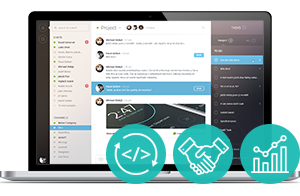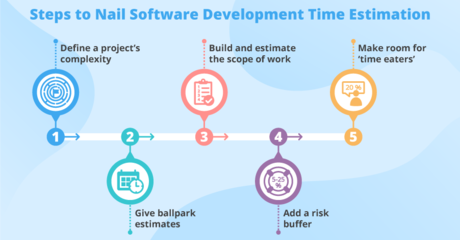Trends in software development are powerful business growth drivers. Some development buzzwords of 2021-2022, like microservices and cloud migration, have already become a common reality in the software industry and proved their value to a number of businesses. In our software development services, they are already a must-have adoption in many projects.
Other software development trends continue maturing and spreading out across industries. In this article, we analyze 4 latest technologies that will influence the software industry in 2024 and beyond and illustrate their benefits with use cases.

AI-first software
According to IDC, global spending on AI will surpass $300 billion in 2026. And according to Gartner, by the end of 2024, 75% of organizations will shift from piloting to operationalizing AI. The latest trend is not as much about integrating AI in existing software as about engineering AI-first software, when AI becomes the starting point of software design. Empowered by such technologies as deep learning, speech recognition or machine vision, it can benefit businesses in many ways:
- Assistance in critical decision-making. In medicine, AI analyzes medical records, genetic data and lab results to foresee diseases or identify more promising treatments.
- Enhanced level of service. From virtual assistants, for example, in healthcare to schedule doctor appointments, to software that recognizes faces and identifies emotions to improve sales and marketing efforts – AI helps create a truly client-oriented service.
- Quality control and risk aversion. In manufacturing, IoT devices send data to AI-based programs that increase production efficiency and predict machinery failures. And, for example, in agriculture, AI helps to analyze plants and detect weeds.
Case study: AI-based application for brain MRI scan analysis
ScienceSoft developed an AI-based application for brain MRI scans analysis. Using the convolutional neural network (CNN) algorithms, the application helps doctors localize brain tumors, plan surgeries and track the treatment progress.
Blockchain beyond the financial sector
Blockchain allows transferring money and information without an intermediary and keeping related records unchangeable and transparent. The mechanism behind it is this: data is encrypted, ‘chained’ with other data entries chronologically and spread across all computer systems in the network instead of being stored in a centralized server.
Due to the innovative way blockchain works, it is being adopted by many industries beyond the financial sector where it firstly appeared: distribution, manufacturing, healthcare, public sector. By the end of 2024, the blockchain market is expected to grow to $20 billion in annual revenues. Let’s see which advantages attract investments in this technology:
- Data safety. Decentralized data storage helps prevent fraud and security attacks for businesses handling sensitive information (credit histories, medical records, records from industrial IoT) as it is encrypted and copied to each computer in the system, which shuts off the possibility to alter it without the approval of all system members.
- Smart contracts. Blockchain allows creating contracts that are executed automatically only after all terms are satisfied. For example, the goods are shipped after the payment is verified through blockchain. As such, it’s impossible to tamper with contract execution.
- Transparency. Businesses can replace paper-based processes with blockchain’s distributed ledger to provide ultimate transparency into transactions and increase the accountability of all parties involved.
Case study: Blockchain to trace the food provenance
Walmart tested the blockchain technology to trace the food provenance by asking several suppliers to upload their data to the distributed ledger and use new special labels on products. This enabled the company to trace, for example, mangoes back to the origin farm in 2.2 seconds through the blockchain-based system compared to 7 days when they had to contact suppliers by phone and email.
Low-code development
Low-code development implies building applications through visual interfaces without coding. Developers drag and drop prebuilt components, while code is created automatically and can be modified if needed.
Low-code platforms facilitate application creation through a graphical user interface (GUI) and drag-and-drop tools. On the other hand, no-code platforms allow users to quickly build applications without coding knowledge using prebuilt templates.
Initially, low-code development was used on platforms-as-a-service specializing in a certain kind of software (e.g., CRM). But now, there’re low-code platforms that allow building almost any-purpose low-code applications. They gain popularity because of major improvements in functionality – microservices support, vast integration possibilities and AI/ML implementation.
Gartner forecasts that low-code platforms will be used in more than 65% of software development projects by 2024. This can be explained by the opportunities low-code development opens for startups, small businesses and enterprises:
- Faster deployment. Low-code applications take significantly less time to build compared to hand-coded applications, which allows adhering to tight timelines imposed by the competitive market environment.
- Validating business ideas with fewer risks. Low-code platforms help cut down on costs compared to custom software development. This is especially useful for developing a cheaper MVP to see if a business idea is worth further investing in.
- Covering the lack of UX resources. Low-code platforms offer integrated UI frameworks with ready-made blocks and widgets that one can use without a profound UX background to create a user-friendly application.
Case study: Low-code development enables to deliver >60 apps in 20 months
Schneider Electric, a multinational provider of energy solutions, needed to support business processes with multiple applications as soon as possible. With low-code development, the company produced more than 60 new apps in 20 months and saved 650+ working days on it.
Progressive Web Apps (PWAs)
PWAs are web apps that function like mobile apps without being downloaded. According to Google, since the beginning of 2021, PWA installs have grown by 270%. PWAs' increasing popularity is caused by two considerable benefits:
- Smooth user experience. PWA works 2-3 times faster than responsive and mobile web pages, displays content even offline, and it is resilient against crashes during intense server load.
- Reduction of development cost and time. PWA is an alternative to native apps; it adapts to all screen sizes and mobile platforms. It’s also rather cost-effective as you can have both a website and an app for the cost of a website.
Businesses that see impressive results from PWAs are ecommerce, hospitality, news sources and social networks – the services where user convenience is critical.
Case study: PWA for the global media company
PWA of the global media company Forbes opens in 2.5 seconds on mobile compared to 6.5 seconds for their regular website. Forbes also stated 2x increase in the average user session length for their PWA.
Get the most out of 2024 development trends
In 2024, you can harvest early benefits with emerging software development trends. ScienceSoft offers engineering innovative software for both enterprises and software product companies.
Discuss Your Software Opportunities with Our Consultant

Looking for an outsourcing partner to take over your software development project or the entire pipeline of projects? ScienceSoft is ready to support your business growth and digital transformation initiatives.



